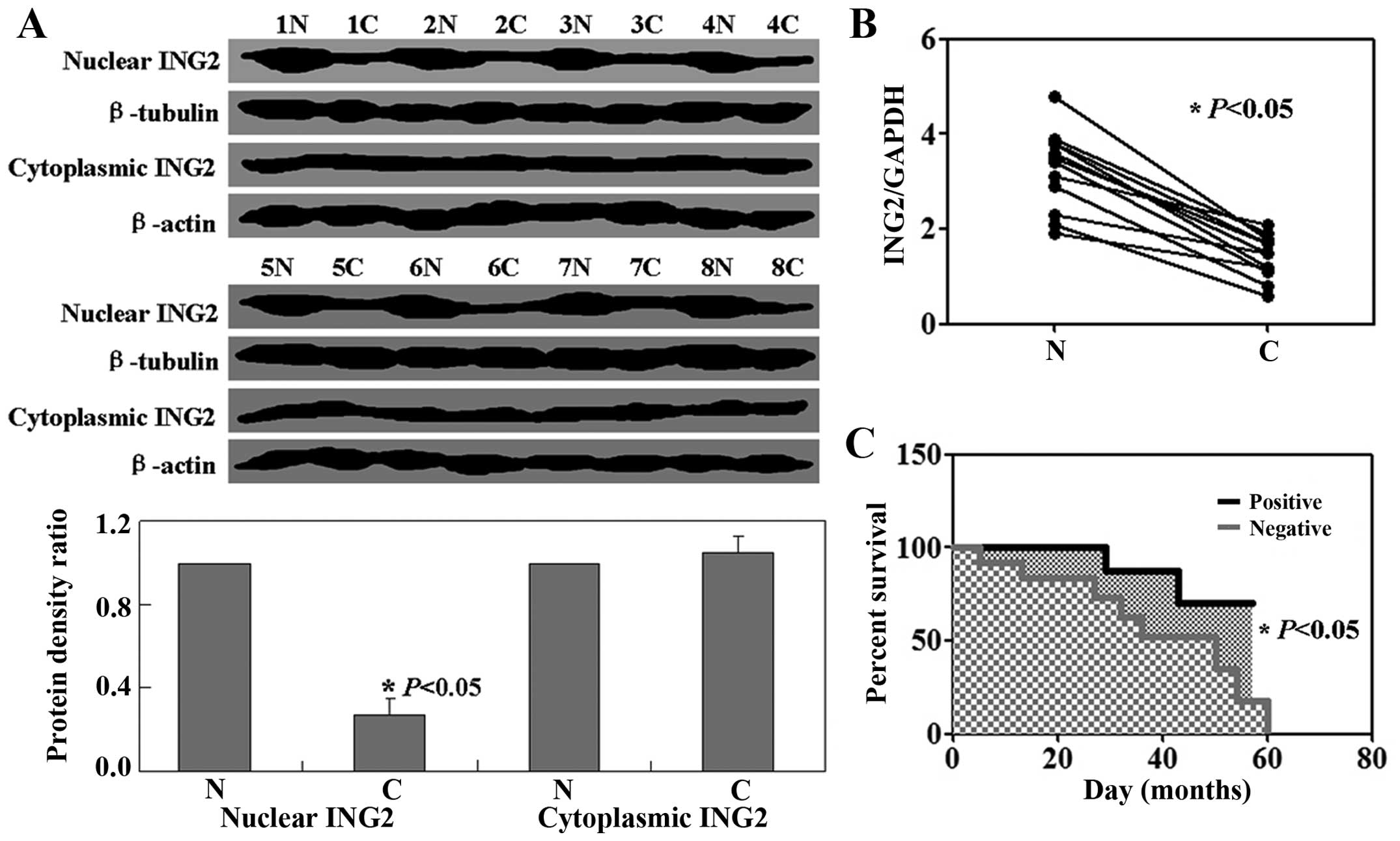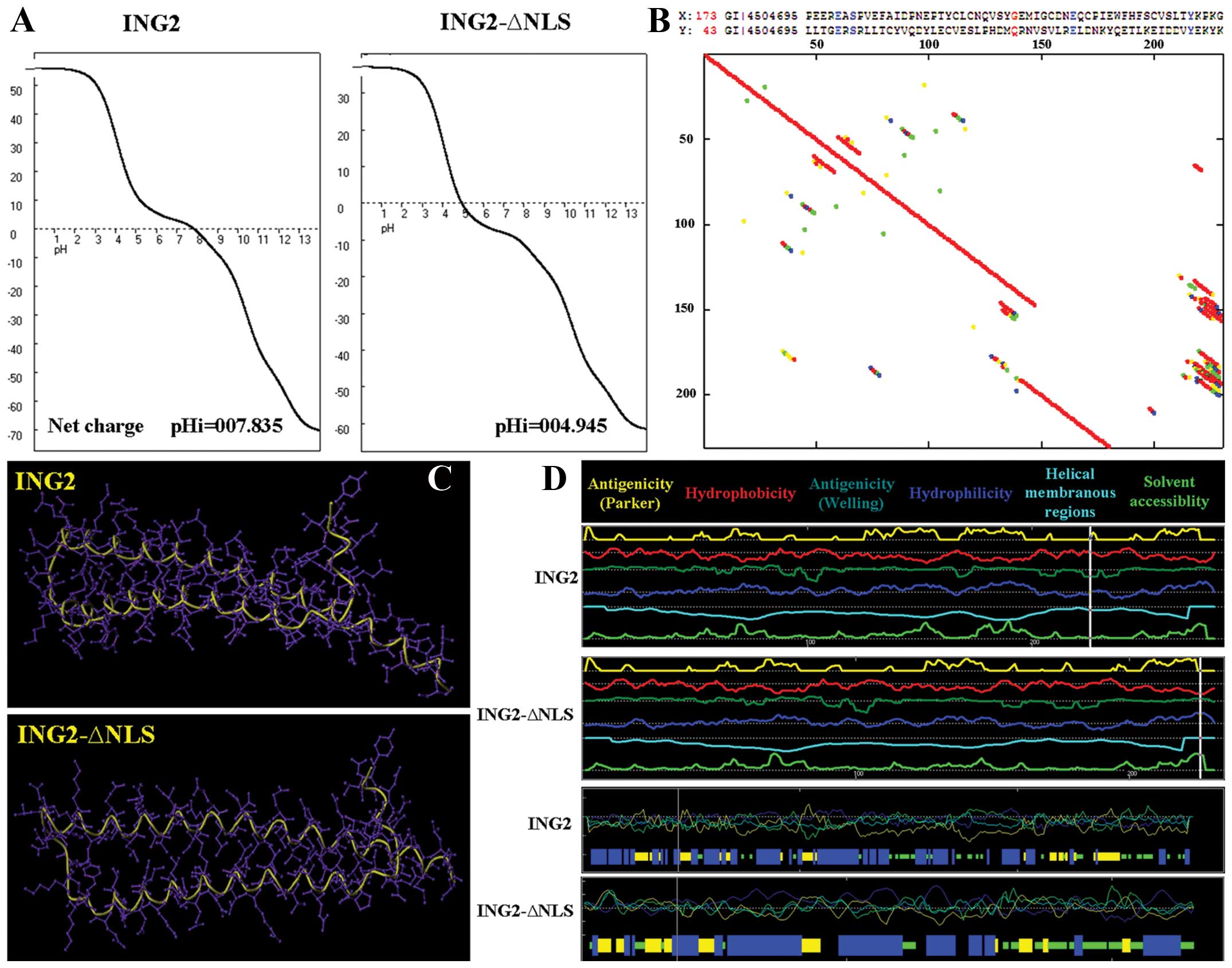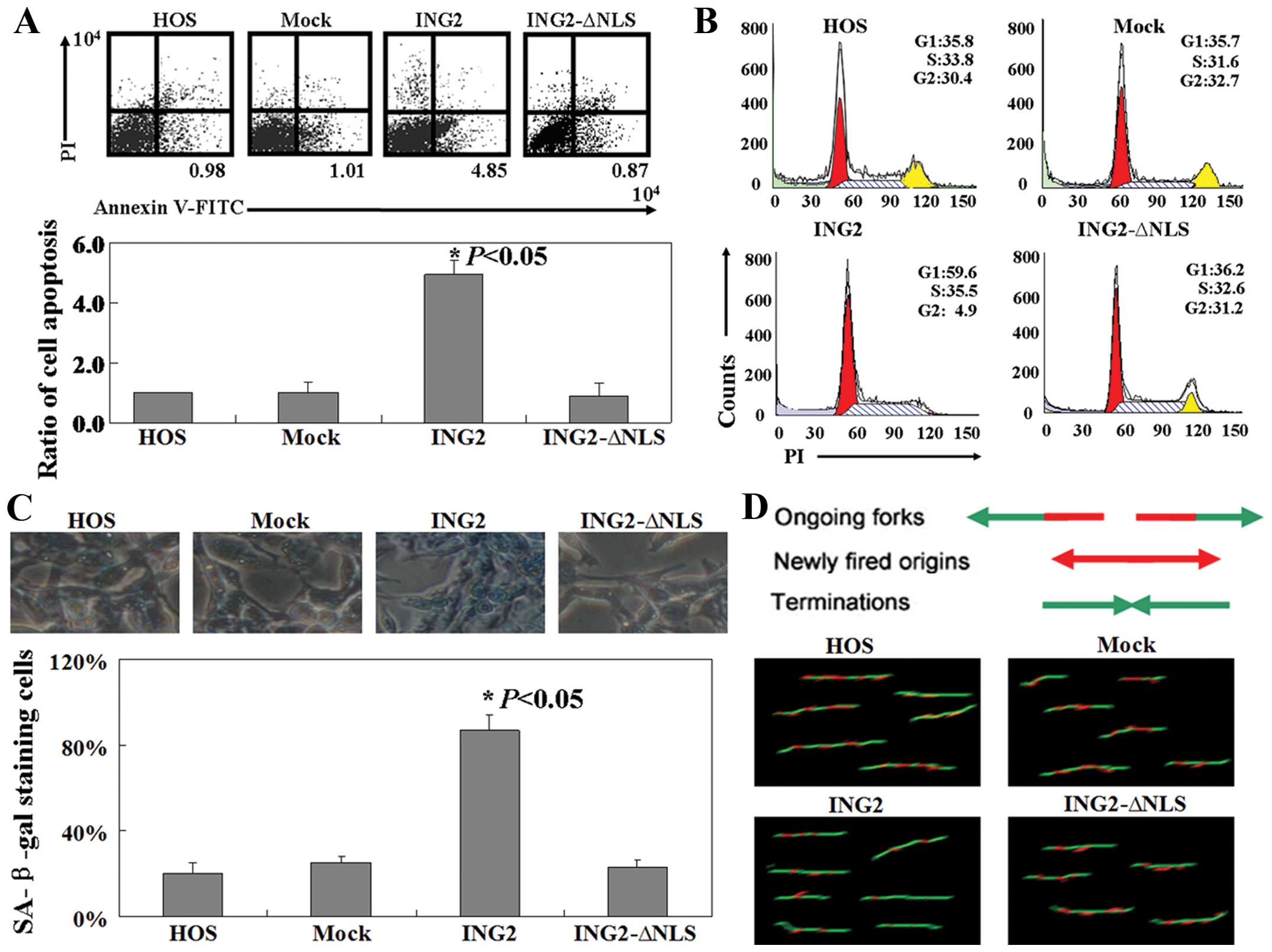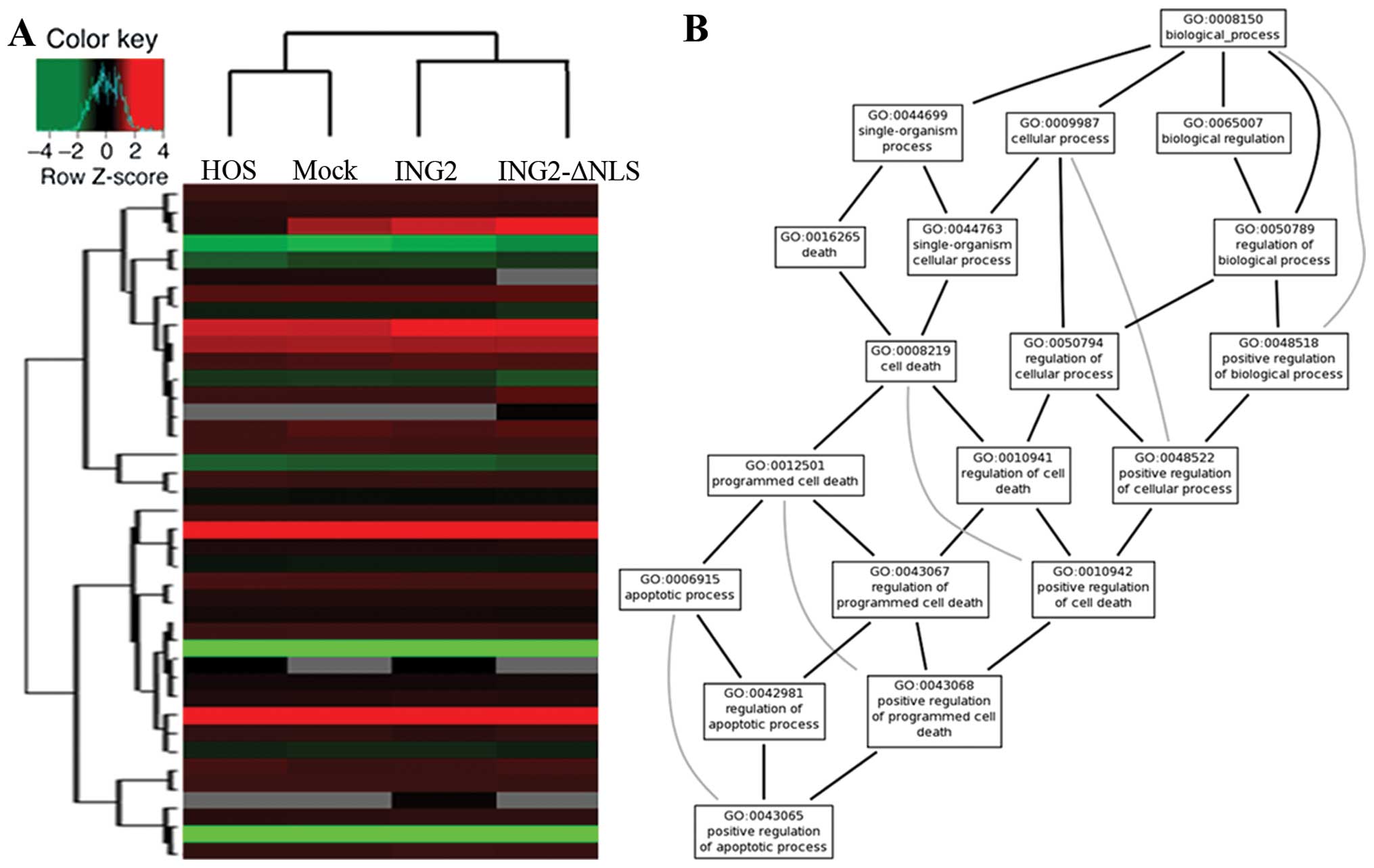Nuclear ING2 expression is reduced in osteosarcoma
- Authors:
- Published online on: September 2, 2014 https://doi.org/10.3892/or.2014.3458
- Pages: 1967-1972
Abstract
Introduction
Osteosarcoma is a primary tumor of the bone that accounts for 5% of all childhood cancers and represents the fifth most common tumor in young adults (1). It usually arises in the metaphysis of long bones such as the distal femur, proximal tibia and proximal humerus (2). Modified chemotherapy and surgical procedures, accompanied by the application of radiotherapy, have not led to any major improvements in the treatment outcome and quality of life of osteosarcoma patients (3). Therfore, it is urgent to further understand the mechanisms involved in the tumorigenesis of osteosarcoma in order to identify new therapeutic targets (4).
The inhibitor of growth (ING) family proteins are candidate tumor suppressors that associate with histone acetyltransferase (HAT), histone deacetylase and factor acetyltransferase complexes (5). Inhibitor of growth 2 (ING2) is the second member of the ING family of candidate tumor-suppressor genes ING1 to ING5 (6–8). ING2 consists of three exons, exon 1a, 1b, and 2, resulting in two transcribed isoforms: ING2a and ING2b (9). Many studies have found that ING2 expression is decreased or lost in human tumors, which suggests a role for ING2 as a tumor-suppressor gene. Borkosky et al (10) found that ING2 LOH may occur in late stages during head and neck squamous cell carcinoma progression. In addition, Zhang et al (11) found that ING2 expression was significantly decreased in hepatocellular carcinoma (HCC) and may lead to an unfavorable prognosis. However, in a study by Kumamoto et al (12), the authors confirmed that ING2 is upregulated in colon cancer. To our knowledge, no related study has demonstrated a relationship between ING2 and osteosarcoma. Our results could help in elucidating the functional role of ING2 in osteosarcoma.
Materials and methods
Tumor cells and osteosarcoma tissue samples
The human osteosarcoma cell line, HOS, was obtained from the American Tissue Type Collection (ATCC, Bethesda, MD, USA) and was maintained in minimum essential medium (MEM; Life Technologies, Gaithersburg, MD, USA) supplemented with 10% (v/v) fetal bovine serum (FBS) and antibiotics (100 U/ml of penicillin and 100 mg/ml of streptomycin) at 37°C in a 5% (v/v) CO2 incubator. All the samples of osteosarcoma tissues and adjacent samples of non-tumorous tissues were obtained from the First Hospital of China Medical University from July 2003 to July 2013, following consent of each patient. The procedure was approved by the China Medical University Ethics Committee.
Real-time PCR
Total RNA was isolated using an RNeasy Mini kit (Biomed, Beijing, China). First-strand cDNA was reverse transcribed with 1 μg of total RNA, using the Takara reverse transcription kit (Takara, Dalian, China) and oligo (dT)15 primers (Takara). The resultant cDNA was then used for quantitative PCR reactions. The ING2 primers were: 5′-GCGAGAGCTGGACAACAAAT-3′ (sense) and 5′-GACACTTGGTTGCATAAGCAG-3′ (antisense). The housekeeping gene, GAPDH, was used as an internal control for normalization of the results. The GAPDH primers were: 5′-AGAAGGCTGGGGCTCATTTG-3′ (sense) and 5′-CGATCCACACGGAGTACTTGC-3′ (antisense). Amplification of ING2 and GADPH was performed with 1 cycle at 95°C for 10 min, and 40 cycles of 95°C for 15 sec and 60°C for 60 sec. Calculation of the relative expression of each transcript was performed using the 2−ΔΔCt method.
Plasmids and transfection
The plasmids, pcDNA3.1-ING2 and pcDNA3.1-ING2-ΔNLS, were kindly provided by Mr. Xin-Yu Zhang (China Medical University, Shenyang). Transfection of the plasmids into HOS cells was performed using Lipofectamine™ 2000 (Invitrogen Gibco, Carlsbad, CA, USA) according to the manufacturer’s instructions. Cell lines transfected with pcDNA3.1 were used as a mock.
Western blot analysis
Nuclear and cytoplasmic proteins were isolated from the cells using the PARIS™ (Protein and RNA Isolation System) kit (Ambion Inc., Austin, TX, USA). Equal amounts (30 μg) of cell lysates were separated by 10% SDS-polyacrylamide gel electrophoresis and transferred to polyvinylidene difluoride membranes, and incubated with the following specific antibodies. The ING2 antibody (sc-67646; Santa Cruz Biotechnology, Santa Cruz, CA, USA) was used to identify transfection efficiency. β-actin and β-tubulin (sc-130675 and sc-9104, respectively; both from Santa Cruz Biotechnology) were used as internal controls. The reaction was followed by probing with peroxidase-coupled secondary antibodies including anti-rabbit IgG or anti-mouse IgG at dilutions ranging from 1:1,000 to 1:2,000 (Amersham Biosciences, Needham, MA, USA), and the binding results were visualized by enhanced chemiluminescence (Amersham Pharmacia, Piscataway, NJ, USA).
Immunofluorescence
Cells were washed with PBS, fixed in 4% paraformaldehyde, permeabilized in 1% Triton X-100 for 5 min, and blocked with 5% bovine serum albumin in PBS containing 0.5% Triton X-100 for 1 h. ING2 was detected using anti-ING2 (Santa Cruz Biotechnology) for 1 h at room temperature. Cells were washed with PBS and incubated with Alexa Fluor® 488 donkey anti-goat IgG (H+L) for 1 h at room temperature. Photographic images were captured using an Olympus CX71 fluorescence microscope (Olympus, Tokyo, Japan).
Physico-chemical profiles of ING2
Physico-chemical profiles, such as titration curve, hydrophobicity (13), antigenicity (14), fexibility (15), and solvent accessibility (16), were analyzed using Antheprot 5.0 software.
The PHYRE database was used to generate predicted structural models
The protein sequence of ING2 was obtained from Pubmed (http://www.ncbi.nlm.nih.gov/protein/AAQ13674.1) and submitted to Protein Homology/analogY Recognition Engine (PHYRE ver. 2). Based on the homology sequence in the PHYRE server, the three-dimensional structure of ING2 protein was predicted.
Cell cycle and apoptosis analyses
Cells were collected in PBS and fixed on ice with 1% paraformaldehyde, followed by 70% cold ethanol containing 10 μg/ml RNase. Then the cells were stained with 50 μg/ml propidium iodide (PI; KeyGen, Nanjing, China) for 15 min at room temperature for cell cycle analysis. The apoptotic cells were detected with Annexin V-FITC/PI double staining. Based on the manufacturer’s instructions for the apoptosis assay kit (KeyGen), the stained cells were analyzed by flow cytometry. Data analysis was performed with CellQuest software (BD Biosciences, Rockville, MD, USA).
SA-β-gal analysis
For SA-β-gal staining, cells were washed twice in PBS, fixed for 3–5 min at room temperature in 3% formaldehyde and washed again with PBS. Then cells were incubated overnight at 37°C without CO2 in a freshly prepared SA-β-gal-staining solution as previously described (17).
DNA fiber spreading
Asynchronous cells were pulsed sequentially with 100 mM BrdU (Zymed Laboratories, San Francisco, CA, USA) and 100 mM IdU (Sigma Aldrich, St. Louis, MO, USA) for 20 min each. Cells were collected and DNA fibers were spread onto microscope slides as described by Jackson and Pombo (18).
Affymetrix GeneChip technology
The total RNA was extracted from the cells as described above. The total RNA samples were then analyzed by CapitalBio Corp., for GeneChip (Affymetrix, Santa Clara, CA, USA) assay, and each treatment had 3 biological replicates that were measured in this manner. Gene expression analysis was performed using the Affymetrix GeneChip, according to the laboratory methods in the Affymetrix GeneChip expression manual. Gene expression analysis was performed using triple arrays and triple independent mRNA samples for each treatment. Microarray data were analyzed using Bio MAS 3.0 software (CapitalBio, Beijing, China). Using the criterion of cutoff limitation as a fold change ≥2 or ≤0.5 and Q-value ≤5%, differentially expressed genes were screened and clustered.
Statistics and survival analysis
Overall survival rates were determined using the Kaplan-Meier estimator. Kaplan-Meier survival plots were generated, and comparisons were made with log-rank statistics. For all analyses, a P value <0.05 was considered to indicate a statistically significant difference. All of the statistical analyses and graphics were performed with GraphPad Prism 5.
Results
Reduced ING2 nuclear expression in osteosarcoma
We examined ING2 expression in osteosarcoma by western blot analysis and real-time PCR. Results showed that the levels of ING2 mRNA and nuclear expression were decreased in tumor tissues relative to the levels in the normal tissues (P<0.05, Fig. 1A and B). There was no significant difference in ING2 cytoplasmic expression between the normal tissues and tumor tissues (P>0.05, Fig. 1A). Follow-up information was available for the patients for periods ranging from 1 month to 5 years (median, 21 months). A Kaplan-Meier analysis showed that ING2 nuclear expression was closely correlated with the favorable prognosis of patients with osteosarcoma, whereas negative ING2 nuclear expression was correlated with a poor prognosis (P<0.05, Fig. 1C).
ING2 expression in HOS cells
HOS cells were transfected with the pcDNA3.1-ING2 or pcDNA3.1-ING2-ΔNLS expression vector. Schematic illustration of pcDNA3.1-ING2 and pcDNA3.1-ING2-ΔNLS are shown in Fig. 2A. The levels of ING2 cytoplasmic and nuclear expression were measured using western blotting (Fig. 2B). As shown in Fig. 2C, the results of immunofluorescence confirmed the location of ING2 in the HOS cells after transfection. Furthermore, titration curve, hydrophobicity, antigenicity, fexibility and solvent accessibility of the ING2 and ING2-ΔNLS proteins did not have a significant difference as assessed using Antheprot 5.0 software (Fig. 3A, B and D). Moreover, the 3D-structures of the two proteins were similar to each other (Fig. 3C).
Effect of ING2 expression on HOS cells in vitro
The ratio of the apoptotic cells present was determined using flow cytometry. As shown in Fig. 4A, the percentage of apoptotic HOS cells in the pcDNA3.1-ING2-transfected group was 4- to 6-times higher than that in the untreated, mock or the pcDNA3.1-ING2-ΔNLS-transfected group (P<0.05). Cell cycle distribution of the transfected and untransfected cells was examined using PI staining. The ratio of cells in the G1 phase was found to be increased in cells in the pcDNA3.1-ING2-transfected group when compared with the ratio in the other three groups (P<0.05, Fig. 4B). Nearly all of the HOS cells in the pcDNA3.1-ING2-transfected group showed strong levels of blue SA-β-gal staining, while cells in the other three groups showed a lower frequency of SA-β-gal staining (P<0.05, Fig. 4C). Moreover, the results of the BrdU/IdU double labeling method showed that less HOS cells in the pcDNA3.1-ING2-transfected group were in the duplicate phase when compared with the other three groups (Fig. 4D).
Affymetrix GeneChip analysis
Clustering of genes based on their relative expression in the HOS cells with ING2 expression compared with the untreated cells was carried out using the Affymetrix® human expression array (Fig. 5A). We arranged the networks of ING2 using Bio MAS (Molecule Annotation System) 3.0 software. However, many of these networks were consistent with the results that were predicted using Gene Ontology (GO) software (http://www.geneontology.org/) (Fig. 5B).
Discussion
The main purpose of the present study was to investigate the roles of the tumor suppressor ING2 in osteosarcoma. We for the first time demonstrated that ING2 nuclear expression was reduced in osteosarcoma. In previous studies, ING2 mRNA expression was found to be reduced in HCCs and in non-small cell lung carcinomas (19,20). Loss of ING2 nuclear expression has been reported in melanoma (21). Notably, in the present study, we found that ING2 was also expressed in the cytoplasm.
In order to fully understand the function of ING2 nuclear and cytoplasmic expression, osteosarcoma cells were transfected with an intact ING2 sequence or an ING2 sequence without a nuclear localization signal (NLS). Firstly, we compared the physico-chemical profiles of the nuclear and cytoplasmic ING2 protein. As shown in Fig. 3, the biochemical and the structural characteristics of the ING2 protein without NLS was similar to the intact ING2 protein. Secondly, we confirmed that nuclear ING2 protein induced apoptosis, G1 phase arrest and senescence in the osteosarcoma cells. Previous research also showed similar functions for ING2. For example, ING2 overexpression in young fibroblasts was found to arrest cells in the G1 phase and induce senescence (22). The PHD finger of ING2 has been implicated in the negative regulation of cell proliferation through modulation of p53 acetylation in response to DNA damage (23). Finally, we detected the mechanism of ING2 in osteosarcoma cells using Affymetrix GeneChip analysis. Previous reports have shown that ING2 interacts with HDAC1 and mSin3A, and has the potential ability to bind to H3K4me3 (5,24). Other studies also found that ING2 interacts with the p300 acetyltransferase to enhance p53 acetylation on lysine 382 to increase transcription of p53 target genes, particularly p21 and Bax to control cell cycle arrest, senescence and apoptosis (6,22). Unfortunately, we did not identify any new mechanism of ING2 in the present study.
Overall, this study provides novel biochemical, structural and functional data on ING2 in osteosarcoma cells. These results thus reinforce the role of ING2 as a tumor-suppressor gene, acting by controlling cell cycle progression and cell proliferation.
Acknowledgements
We are indebted to Mr. Xin-Yu Zhang for the pcDNA3.1-ING2 and pcDNA3.1-ING2-ΔNLS plasmids.
References
|
Bielack SS, Kempf-Bielack B, Delling G, et al: Prognostic factors in high-grade osteosarcoma of the extremities or trunk: an analysis of 1,702 patients treated on Neoadjuvant Cooperative Osteosarcoma Study Group protocols. J Clin Oncol. 20:776–790. 2002. View Article : Google Scholar | |
|
Meyers PA and Gorlick R: Osteosarcoma. Pediatr Clin North Am. 44:973–989. 1997. View Article : Google Scholar : PubMed/NCBI | |
|
Dai X, Ma W, He X and Jha RK: Review of therapeutic strategies for osteosarcoma, chondrosarcoma, and Ewing’s sarcoma. Med Sci Monit. 17:RA177–RHA190. 2011. | |
|
Watson RL, Spalding AC, Zielske SP, et al: GSK3beta and beta-catenin modulate radiation cytotoxicity in pancreatic cancer. Neoplasia. 12:357–365. 2010.PubMed/NCBI | |
|
Shi X, Hong T, Walter KL, et al: ING2 PHD domain links histone H3 lysine 4 methylation to active gene repression. Nature. 442:96–99. 2006.PubMed/NCBI | |
|
Nagashima M, Shiseki M, Miura K, et al: DNA damage-inducible gene p33ING2 negatively regulates cell proliferation through acetylation of p53. Proc Natl Acad Sci USA. 98:9671–9676. 2001. View Article : Google Scholar : PubMed/NCBI | |
|
Nagashima M, Shiseki M, Pedeux RM, et al: A novel PHD-finger motif protein, p47ING3, modulates p53-mediated transcription, cell cycle control and apoptosis. Oncogene. 22:343–350. 2003. View Article : Google Scholar : PubMed/NCBI | |
|
Shiseki M, Nagashima M, Pedeux RM, et al: p29ING4 and p28ING5 bind to p53 and p300 and enhance p53 activity. Cancer Res. 63:2373–2378. 2003.PubMed/NCBI | |
|
Guérillon C, Larrieu D and Pedeux R: ING1 and ING2: multifaceted tumor suppressor genes. Cell Mol Life Sci. 70:3753–3772. 2013.PubMed/NCBI | |
|
Borkosky SS, Gunduz M, Nagatsuka H, et al: Frequent deletion of ING2 locus at 4q35.1 associates with advanced tumor stage in head and neck squamous cell carcinoma. J Cancer Res Clin Oncol. 135:703–713. 2009. View Article : Google Scholar : PubMed/NCBI | |
|
Zhang HK, Pan K, Wang H, et al: Decreased expression of ING2 gene and its clinicopathological significance in hepatocellular carcinoma. Cancer Lett. 261:183–192. 2008. View Article : Google Scholar : PubMed/NCBI | |
|
Kumamoto K, Fujita K, Kurotani R, et al: ING2 is upregulated in colon cancer and increases invasion by enhanced MMP13 expression. Int J Cancer. 125:1306–1315. 2009. View Article : Google Scholar : PubMed/NCBI | |
|
Kyte J and Doolittle RF: A simple method for displaying the hydrophobic character of a protein. J Mol Biol. 157:105–132. 1982. View Article : Google Scholar | |
|
Hopp TP and Woods KR: Prediction of protein antigenic determinants from amino acid sequences. Proc Natl Acad Sci USA. 78:3824–3828. 1981. View Article : Google Scholar : PubMed/NCBI | |
|
Vihinen M, Torkkila E and Riikonen P: Accuracy of protein flexibility predictions. Proteins. 19:141–149. 1994. View Article : Google Scholar : PubMed/NCBI | |
|
Trier NH, Hansen PR and Houen G: Production and characterization of peptide antibodies. Methods. 56:136–144. 2012. View Article : Google Scholar : PubMed/NCBI | |
|
Dimri GP, Lee X, Basile G, et al: A biomarker that identifies senescent human cells in culture and in aging skin in vivo. Proc Natl Acad Sci USA. 92:9363–9367. 1995. View Article : Google Scholar : PubMed/NCBI | |
|
Jackson DA and Pombo A: Replicon clusters are stable units of chromosome structure: evidence that nuclear organization contributes to the efficient activation and propagation of S phase in human cells. J Cell Biol. 140:1285–1295. 1998. View Article : Google Scholar | |
|
Walzak AA, Veldhoen N, Feng X, Riabowol K and Helbing CC: Expression profiles of mRNA transcript variants encoding the human inhibitor of growth tumor suppressor gene family in normal and neoplastic tissues. Exp Cell Res. 314:273–285. 2008. View Article : Google Scholar | |
|
Ythier D, Brambilla E, Binet R, et al: Expression of candidate tumor suppressor gene ING2 is lost in non-small cell lung carcinoma. Lung Cancer. 69:180–186. 2010. View Article : Google Scholar : PubMed/NCBI | |
|
Lu F, Dai DL, Martinka M, Ho V and Li G: Nuclear ING2 expression is reduced in human cutaneous melanomas. Br J Cancer. 95:80–86. 2006. View Article : Google Scholar : PubMed/NCBI | |
|
Pedeux R, Sengupta S, Shen JC, et al: ING2 regulates the onset of replicative senescence by induction of p300-dependent p53 acetylation. Mol Cell Biol. 25:6639–6648. 2005. View Article : Google Scholar : PubMed/NCBI | |
|
Gozani O, Karuman P, Jones DR, et al: The PHD finger of the chromatin-associated protein ING2 functions as a nuclear phosphoinositide receptor. Cell. 114:99–111. 2003. View Article : Google Scholar : PubMed/NCBI | |
|
Pena PV, Davrazou F, Shi X, et al: Molecular mechanism of histone H3K4me3 recognition by plant homeodomain of ING2. Nature. 442:100–103. 2006.PubMed/NCBI |














